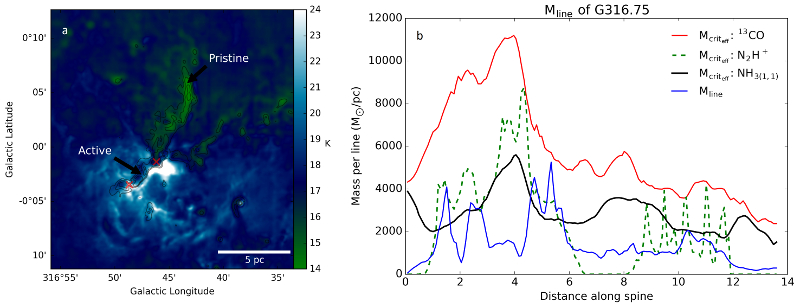| EPoS Contribution |
|
Massive Star Formation and the Impact of Stellar Feedback: The Case of the G316.75 Massive Star-Forming Ridge
Elizabeth Watkins Cardiff U, Cardiff, UK | |
| Star formation and stellar feedback regulate the pace of galaxy evolution in the Universe. While star formation converts cold molecular gas into stars, stellar feedback limits its efficiency by inputting energy and momentum into interstellar clouds. On scales of giant molecular clouds, average star formation efficiencies are typically of a few percent. However, it is unclear how feedback impacts star formation efficiencies at different gas density regimes within individual clouds, and whether the dominant impact of feedback is positive or negative. The key issue in observationally constraining the impact of feedback on massive-star-forming clouds is determining the gas properties before the first massive star formed. The main factor preventing this is the rarity of massive star formation environments. Consequently, observing the dominant effect and impact of feedback remains elusive. To address this, we present new results obtained on the G316.75 massive star-forming cloud (21,000 Msun located 2.7 kpc away), a unique ridge that is half infrared dark, half infrared bright (both in mass and area). The infrared bright half has already formed 2 O-type stars but the infrared dark part is still quiescent. By using the gas properties of the infrared dark part of the ridge as a model for the initial conditions of the active part, we can quantify the impact that feedback has on the density structure and fragmentation properties of the ridge along with its kinematics. For that purpose we use MALT90, ThrUMMS and HOPS molecular line data, along with Herschel/HiGAL observations processed using the Bayesian technique PPMAP that provides us with unprecedented resolution (0.08pc). We show that the gas properties are significantly affected by feedback for the entire density range probed by the observations. However, while the more diffuse gas is being pushed away to form bipolar lobes, the dense gas remains self-gravitating. The diffuse gas surrounding the quiescent part is also affected by the feedback from the active part. Altogether, this strongly suggests that the impact of feedback regarding star formation efficiency is to limit further mass accretion onto the self-gravitating part of the cloud without preventing the already formed dense gas from collapsing to form more stars. | |
 | |
| Caption: Mean dust temperature map derived using PPMAP. This figure shows the stark difference between the active infrared bright region and the pristine infrared dark region of G316.75 with blue tracing the hot dust temperatures and green tracing the colder dust temperatures. The three contours show column density at levels 4, 8, 16 × 1022 cm-2. The red crosses show the locations of the 2-Otype stars already formed, estimated using SUMMS radio continuum data. (b) Line mass and effective, turbulent line mass of G316.75 calculated using a column density spine and velocity data. The large increases in physical line mass correspond to locations that contain high column density features e.g. at core location. The largest effective line traced by 13CO data demonstrates the diffuse gas is not as bound as the dense gas. The drop in effective line mass between 6 and 8 pc for N2H+ results from missing MALT90 data. | |
| Collaborators: N. Peretto, Cardiff U, UK K. Marsh, Cardiff U, UK |
Suggested Session:
High-mass star/star cluster formation |

